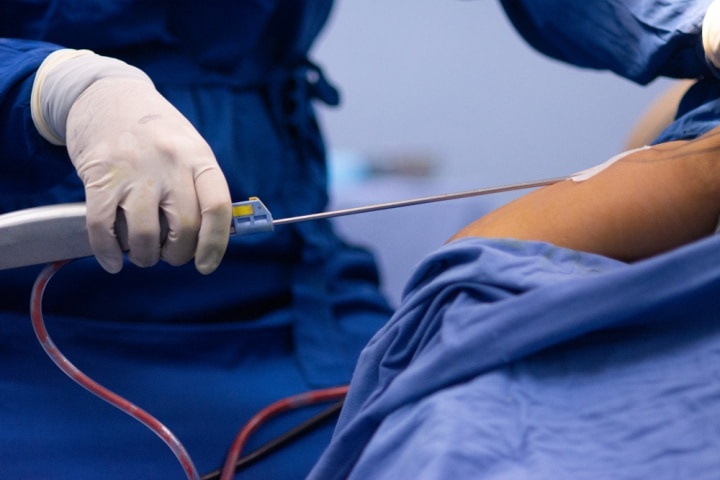
Who’s A Good Candidate for Liposuction?
Liposuction is an excellent procedure for anyone looking to get rid of stubborn, excess fat that they’re having a difficult time losing from traditional methods like diet and exercise.
People who are not an ideal candidate are those who’ve had multiple body procedures, including non-invasive ones such as Coolsculpting. The more things you have done, the underlying fat develops scar tissue, which makes the subsequent liposuction less effective. Even if you have fat cells in between the scars, the plastic surgeon can’t control it as much and we’ll retrieve less fat in the process.
It’s best to have well-done lipo done once or twice over your lifetime, and it certainly shouldn’t be viewed as an easy fix or used as gym pass! This procedure is not intended for routine maintenance.
How painful is liposuction?
Liposuction is mostly performed under general anesthesia; however, there are some places that perform awake liposuction where the patient only receives local anesthesia. If you’re having awake lipo, you may feel some “dings” during the procedure but it shouldn’t be painful.
When you’re under general, you’re not going to feel anything during the surgery but when you wake up, you’re likely going to experience discomfort within that first week. I would say that liposuction and tummy tucks cause the most post-op soreness compared to breast and other body procedures.
I don’t perform a lot of awake liposuctions nor do I typically recommend it. That said, it ultimately comes down to individual preference and should be discussed between the patient and surgeon. Some people are at high risk for general anesthesia and in those instances, might want to consider awake.
I don’t like doing awake because I feel that I’m unable to get the patient as comfortable as I’d like them to be and this can sometimes make the procedure last longer than it would under general
Some of the awake centers will narc the patient out, which is a huge airway concern. If the patient’s airway clamps down, that can be an incredibly dangerous situation. Under general anesthesia, I can be rest assured that the patient is comfortable and safe while under the careful watch of an anesthesiologist.
How long is liposuction recovery?
During that first week, you’re going to feel swollen, bloated, and uncomfortable. The reality is, many patients won’t see or feel any results in the beginning – don’t let this discourage you because as each week passes by you’re going to see that swelling go down.
Patients will wear a compression garment and as your body begins to heal, you’ll downsize your garment and your results will show more and more. For all swelling and tissue to soften and heal, it takes around three months for patients to see full results.
As far as downtime goes, it really depends on how much lipo you had and where. Was it just the arms? Just the abdomen? Most of these patients can begin to go about their normal routines and return to work after a couple of days.
Whereas patients who have whole body liposuction or Lipo 360 are going to feel pretty sore, find themselves getting tired easily, and slow to move around, so they’re normally confined to their home for that first week and will likely need help from family or friends. But after that first week, these patients are generally pretty mobile.
How long will liposuction last?
Liposuction is permanent as long as the patient upkeeps the diet and exercise routine they established prior to surgery. If you happen to lose weight naturally after surgery, then you’re going to see even greater results. If you gain weight, then obviously your results are going to be less noticeable.
Many of my patients mention they’ve heard if you gain weight after liposuction, the fat will not grow back in the targeted area and will redistribute to another area of the body. This isn’t entirely accurate.
Whenever you gain weight, your fat cells increase in size – you’re not accumulating additional fat cells. After liposuction surgery, the donor site is going to have a lower amount of fat cells since some were removed during the procedure.
Because you have fewer fat cells in the liposuction area, you won’t notice the weight gain in that area as much but the fat cells that are left are getting larger. There are are simply less of them, so it may not be as noticeable.
On the flip side, if you’ve had fat transfer to an area of your body, weight gain will likely be more visible in those areas since additional fat cells were added.
How much weight can you lose with liposuction?
The fat that we remove is calculated in volume, which includes both fat cells and fluids. That said, it’s hard to translate this into density. People might even gain weight after surgery from swelling and fluids. You won’t really know the weight change until your swelling completely subsides.
The American Society of Plastic Surgeons, and other leading industry organizations, recommend the maximum volume surgeons should remove in one sitting is 5 liters, but this is interpreted differently. Some providers will say that the 5 liters includes that mixture of fat and fluid; while others argue that the 5 liters only encompasses fat. Generally, most associations will say that the safe assumption is to remove 5 liters of fat/fluid mixture at one time.
What is Lipo 360?
Lipo 360 is a body contouring procedure. We don’t just remove fat from a single area, but sculpt the full body. If you’re a generally larger person, removing a significant amount of fat from only one area doesn’t tend to look natural. The 360-degree approach allows patients to have a more natural 3D figure.
